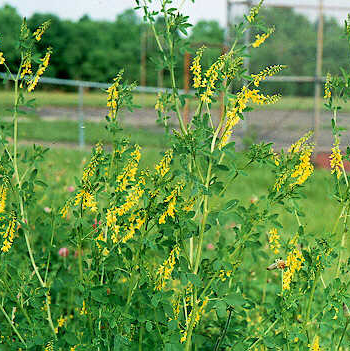Contents:
Common Names | Parts Usually Used | Plant(s) & Culture | Where Found | Medicinal Properties | Biochemical Information
Legends, Myths and Stories | Uses | Formulas or Dosages | Warning | Bibliography
Scientific Names

- Melilotus officinalis L.
- Pea family
Common Names
- Hay flowers
- Honey lotus
- Hsun-ts’ao (Chinese name)
- King’s clover
- Yellow Melilot
- Yellow sweet clover
Parts Usually Used
The flowering plant
Back to Top
Description of Plant(s) and Culture
Yellow melilot is a biennial plant; the slender, branched, hollow stems, from 1 1/2 to 5 feet high, bear pinnate leaves (clover-like) with 3 obovate or oblanceolate leaflets, which are finely toothed and blunt-tipped. Blooming from June to November, the fragrant, light golden-yellow pea-like flowers grow in axillary racemes. Later, long crooked pods appear, they contain flat brown seeds. The plant is fragrant when crushed.
Another variety: White melilot (M. alba), a similar but taller, white-flowered species, has the same medicinal uses. Biennial, grows 1-9 feet tall, leaves clover-like; leaflets elongate, slightly toothed. Small white, pea-like flowers in long, tapering spikes, blooms April to October. Like yellow melilot, it is a very common plant in fields and waste places over most of North America and in Europe and Asia.
Back to Top
Where Found
Grows along roadsides and in waste places in Eurasia and throughout North America, except in the far north.
Back to Top
Medicinal Properties
Antispasmodic, diuretic, emollient, expectorant, vulnerary
Back to Top
Biochemical Information
Coumarins in both of these clovers may decrease blood clotting.
Back to Top
Legends, Myths and Stories
The name melilot is derived from the words mel, or honey, and lotus; meaning honey lotus.
Yellow melilot repels moths. Europeans sew the dried plant into an herb pillow.
This herb is abundant in the Yangtse region of China. The Chinese use yellow melilot medicinally, use it in cosmetics, and burn it as an incense.
Moldy hay causes uncontrollable bleeding in cattle due to coumarins. Science has developed compounds like warfarin from such coumarins to prevent blood clotting in rodents.
Back to Top
Uses
Used externally in a salve or as a poultice for swellings, boils, and similar skin problems, old sores, wounds, swellings, milk knots, arthritis, rheumatism. The decoction used as a wash for wounds, aching muscles, convulsions, varicose veins, anti-inflammatory, eyewash. Internally it is used for colic, stomach problems, gas, diarrhea, painful menstruation, smoked for asthma, and headaches and chronic bronchitis. Used as a tea, (take 1 cup 3 times a day), this herb is helpful where there is weakness of tone of the penis and partial impotence. A concentrated preparation made from the plant is sometimes prescribed by doctors as an anti-coagulant to break up blood clots. Components of this herb may lower blood pressure but care should be taken, it also lowers blood clotting.
Back to Top
Formulas or Dosages
Infusion: steep 1 tsp. herb in 1 cup boiling water. Take 1 to 1 1/2 cups per day.
Poultice: put about 1/2 oz. dried plant into a small cloth bag. Boil briefly in water; let steep a few minutes; then apply as hot as can be
Back to Top
Warning
Do not use with warfarin or other blood-thinning drugs, or with any blood-clotting problem. See the doctor.
Coumarins in both of these clovers may decrease blood clotting.
Large doses can cause vomiting and other symptoms of poisoning.
Do not use without medical supervision.
Back to Top
Bibliography
![]() The Complete Medicinal Herbal
The Complete Medicinal Herbal, by Penelope Ody, Dorling Kindersley, Inc, 232 Madison Avenue, New York, NY 10016, First American Edition, copyright 1993
![]() Culpeper’s Complete Herbal & English Physician: Updated With 117 Modern Herbs
Culpeper’s Complete Herbal & English Physician: Updated With 117 Modern Herbs, by Nicholas Culpeper, Meyerbooks, publisher, PO Box 427, Glenwood, Illinois 60425, 1990, (reprint of 1814)
![]() The Herbalist Almanac
The Herbalist Almanac, by Clarence Meyer, Meyerbooks, publisher, PO Box 427, Glenwood, Illinois 60425, copyright 1988, fifth printing, 1994
![]() Eastern/Central Medicinal Plants
Eastern/Central Medicinal Plants, by Steven Foster and James A. Duke., Houghton Mifflin Company, 215 Park Avenue South, New York, NY 10000
![]() The Herb Book
The Herb Book, by John Lust, Bantam Books, 666 Fifth Avenue, New York, NY. copyright 1974.
 Secrets of the Chinese Herbalists
Secrets of the Chinese Herbalists, by Richard Lucas, Parker Publishing Company, Inc., West Nyack, NY, 1987.
![]() Webster’s New World Dictionary
Webster’s New World Dictionary, Third College Edition, Victoria Neufeldt, Editor in Chief, New World Dictionaries: A Division of Simon & Schuster, Inc., 15 Columbus Circle, New York, NY 10023
